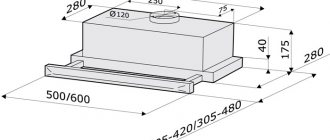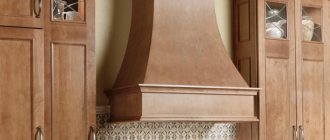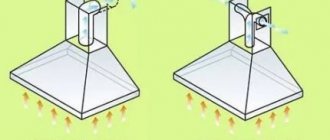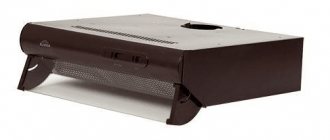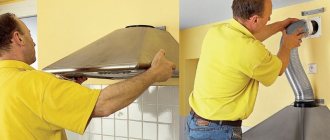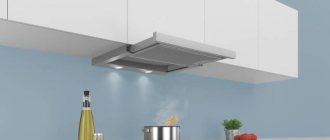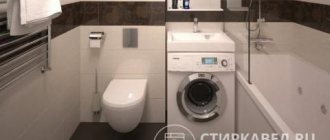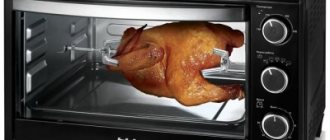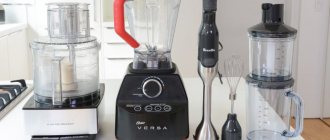.
The kitchen is the most popular place in the apartment. Cooking on a gas stove pollutes the kitchen atmosphere with natural gas vapors, combustion products, grease particles and unpleasant odors. For apartment dwellers, constant inhalation of dirty air causes drowsiness, increased fatigue, poor appetite and even respiratory diseases.
A range hood is an almost necessary element of every kitchen.
Installing a hood in the kitchen will help avoid unpleasant consequences. The market offers a huge variety of exhaust equipment. In order not to get confused, you need to study what models there are and how they work.
Exhaust equipment and its design
A household hood is a specialized device that cleans the air of impurities, smoke, and unpleasant odors released during the cooking of food. The design of this device consists of several parts, such as a housing, a ventilation unit, filters for trapping grease, and a control panel. Grease filters protect the motor and the internal surface of the equipment from the accumulation of fatty deposits.
All components of this equipment are made from materials resistant to rust and temperature changes. The body of the device is made of stainless steel as standard. A modern model, in addition to the function of air purification, can at the same time be a decoration for the kitchen, and also serves as a design object. Therefore, in addition to stainless steel, glass, wood, ceramics are used to make the body, and the hood is decorated with various decors.
Hood design elements
Housing and ducts
A modern hood consists of several elements - and below we will consider each of them in some detail.
Let's start looking at the details with those that are in sight:
Decorative body
- The design of the housing and air ducts is important, first of all, for flow-type hoods. Hoods with filters do not have an air duct as such - and the body serves almost exclusively a decorative function.
- The only problem is exhaust hoods. As a rule, they are made in the form of fairly large domes. This shape facilitates the suction of air over the stove and prevents polluted air from spreading throughout the kitchen.
- The surface of the housing - both internal and external - should be periodically cleaned of grease deposits. If this needs to be done outside to ensure an attractive appearance, then inside - to keep the hood in working condition.
- Air ducts can also be of different shapes, but most often, as we noted above, they are made round or square in cross-section. The optimal diameter of the air duct is 150 mm or more.
Air duct installation
Note! The fewer bends (i.e. turns) the air duct has, the more efficient the hood works. Each rotation of the air duct by 90° reduces the hood performance by 10%.
Engine and “filling”
Next in line will be the engine - the “heart” of our hood. Some models have two engines installed, which provides a significant increase in power.
As a rule, kitchen hoods are equipped with electric motors with a power of 50 to 200 watts and operating speeds of 1500 to 2000 rpm. The performance of the hood, as well as the volume of its energy consumption, directly depends on the engine power.
Motor for hood
Note! An important parameter when choosing a hood is the volume of its engine. As a rule, more powerful engines operate noisier, so you should not buy a hood with a large power reserve - after all, it will also make much more noise.
In addition to the motor, the energy consumption of the hood is also affected by the installed lamps, which provide directional illumination of the stove or work surface. Either halogen or LED lamps are installed as lighting.
The second option is more economical, since halogen lamps consume almost the same amount of energy as standard incandescent lamps.
A cord is used to connect the hood to the mains (220V, 50Hz). As a rule, its length is no more than two meters, so you often have to either use an extension cord or install a surface-mounted socket.
Note! The current is about 1A, so to connect the socket you need wires with a cross-section of 0.75 mm2 or more.
In fact, the electrical circuit of a kitchen hood is not particularly complicated. That is why, if you have the appropriate skills, you can repair the electrical part of the hood yourself.
Schematic diagram of a kitchen hood: to help the master
Anti-grease filter
The next element of the hood that we will consider is the grease filter.
This filter is installed “at the inlet” in almost any type of hood, and not only cleans the air from large impurities, but also protects the engine and electrical components from grease deposits.
Grease filter
- The grease filter is a cassette made of metal mesh or perforated foil, placed in several layers. When choosing a hood model, it is better to give preference to those devices whose anti-grease filters are equipped with an anti-corrosion coating.
- Inexpensive hoods can also be equipped with disposable anti-grease filters. Such filters are made from synthetic fabric and require periodic replacement. And although the price of such a filter is quite low, it is still better to purchase models with metal grease traps.
- The anti-grease filter requires periodic cleaning to remove contamination. To remove grease, dishwashing detergent is most often used - as a rule, this is sufficient.
Carbon filter
For finer filtration, and most importantly, to clean the air from unpleasant odors, carbon filters are used in recirculating hoods:
Carbon filters for different models of hoods
- The carbon filter is installed behind the hood motor, which ensures that air passes through it under significant pressure.
- The design of the carbon filter includes a plastic housing, inside of which there is carbon powder or carbon granules.
- You should avoid wetting the carbon filter, as caked carbon creates resistance to air flow, reducing the hood's power.
- Carbon filters are disposable filters and therefore require replacement at the end of their service life. Typically, information about the operating time of the filter is contained in the instructions for the hood itself.
Replacement of carbon filters is quite simple - to do this, just press the latches and remove the filter housing from the mounts. Do not use excessive force to avoid damaging the latches. If you are in doubt about how to properly remove the filter for replacement, we recommend that you watch an explanatory video.
We hope that the information presented in this article about how a kitchen hood works will be useful to you. And when the time comes to make a choice in favor of one model or another (see also how to choose a hood for the kitchen) - you will choose the device that best suits your requirements.
Did you like the article? Subscribe to our Yandex.Zen channel
Great article 0
How do household hoods work?
There are several types of kitchen hoods. The principle of operation is the main criterion for distinguishing models. Each type has its own disadvantages and advantages. Types of equipment according to operating principle:
- flow type;
- circulation type;
- mixed.
Operating principle of flow and circulation hood
The flow-through model is connected to the general ventilation system of the house. It is equipped with an air duct through which contaminated air exits into general ventilation. Clean air enters the kitchen from other rooms or from open windows.
The circulation hood is not connected to the ventilation system by an air duct. Air contaminated with fumes and odors is cleaned in a filter system and then returned to the kitchen. How does a kitchen hood with a circulation mechanism work? It has an air collector with a filter system into which contaminated kitchen air enters.
Also, this type of hood is equipped with a powerful motor for greater efficiency. Circulating hoods are well suited for kitchens where the ventilation duct is located away from the stove. They can be installed in old houses with poor ventilation. Typically, a circulation hood is equipped with activated carbon filters; they need to be changed periodically.
Mixed hoods have an air duct and a filter system. They work using both a circulation and a flow mechanism. In winter, you can set the circulation type of operation to keep the apartment warm. To turn a flow-through unit into a mixed one, a filter system is installed inside.
Flow hood has one significant drawback. When turned off, it interferes with the natural circulation of air in the kitchen because it closes the ventilation.
This makes it necessary to leave windows open. The circulation hood does not have this drawback. But it also has its drawbacks. The kitchen hood with circulation mechanism is very noisy. This is due to the increased engine power. The price of filters for circulation hoods is high, and they need to be changed regularly.
The design of the hood and its principle of operation
The principle of organizing a kitchen hood with a conventional ventilation duct
The operating principle of a kitchen hood is similar to a vacuum cleaner. A fan rotating inside the device draws in air, thereby creating a low-pressure zone in front of the housing. Air currents rush towards it, collecting fumes, dust and masses waste during the breathing process of people on their way. Since hoods are located directly above the stove, combustion products, evaporations and fatty secretions enter them. If the food burns, the equipment will absorb the smoke, preventing it from spreading throughout the apartment.
The hood is designed simply, but functionally:
- Frame. Serves to accommodate parts and mechanisms. Has different colors and sizes. Made from stainless steel, plastic or black enameled iron.
- Input filter. It is a dense grille located behind the front or bottom panel. Designed to trap fat and soot.
- Electrical engine. It is used to rotate the propeller and is manufactured in a sealed casing that prevents moisture from getting inside. Some manufacturers install two low-power motors that make less noise.
- Fan. Today, drum-type products are more often installed, which are more efficient than axial ones.
- Lighting. Made from 220 V lamps or 12 V LED boards powered by a stabilizer. Designed to illuminate the hob.
- Air duct. They are a pipe that drains pollution to the street or into the common shaft of an apartment building. There are no air ducts in recirculation-type devices; the air is passed through mechanical filters on the top of the housing.
The retail chain offers a wide range of household appliances. To make the right decision, you should study the features of the product, as well as the processes that occur when the kitchen hood operates.
Options for selecting a kitchen hood
Installing exhaust equipment in the kitchen is a necessary and moderately difficult task. Before buying an air purifier, familiarize yourself with the basic criteria for choosing a model; you need to know how the hood works. The design of the hood plays an important role:
- air purifier operating mechanism;
- type of hood installation;
- hood size parameters;
- efficiency of the hood;
- the material from which the hood is made;
- noise level of the hood.
Everything is already clear about the operating principle of a kitchen hood. Let's look at other parameters in more detail.
How a kitchen hood works
How does the hood work? In order to understand how a kitchen hood works, it is necessary to give an example of several modes - recirculation and air exhaust.
In the first case, this principle is perfect for owners of private houses. The development and creation of a ventilation duct system takes a lot of money and effort. Recirculation absorbs air, passing it through carbon filters, and releases it back into the room. The disadvantage of this mode is low performance.
In apartments where there are ventilation ducts and an established ventilation system, it is best to install a kitchen hood with air exhaust. The principle of operation is that the absorbed air moves into the channel and is discharged outside the house.
The kitchen hood operates using electricity. There are many connection variations: some connect an electrical cable to the equipment, others purchase hoods that connect to the network using an outlet.
Types of installation of household exhaust devices
Air purifiers differ not only in operating principles, but also in types of installation.
- Flat hanging models. They are a canopy and are installed above the stove on the wall. A kitchen hood of this type is not always efficient enough, but has a varied design and small size.
- Ceiling air purifiers. They are attached to the ceiling. Island models are only suitable for large and spacious rooms.
- Built-in models. Mounted inside a cabinet hanging above the stove. The most compact type of hoods. They are closed with a cabinet, which allows you not to overpay for the design.
Each type has its own capabilities. Flat hanging models have an interesting design. Ceiling air purifiers are more powerful.
Hood device in the kitchen
Kitchen hood without duct
It is impossible to imagine a modern kitchen without a hood, which rids the room of fumes and odors during cooking. This problem is most pressing in apartments with a living room, where the kitchen is connected to the sitting area and therefore there is no way to close the door while cooking.
In some apartments, the gas stove and the ventilation shaft are located at a considerable distance from each other. Such apartment owners are most often interested in the question: “Is there a hood without an air duct?”
There are two types of kitchen exhaust hood designs: exhaust air and circulating air . Circulation models - hoods with a filter without an air duct, flow-through models - remove combustion products through the air duct into the ventilation system.
General principles of operation of the hood
The principle of air exchange is incorporated into the operation of flow devices with an air duct. The steam or kitchen air drawn into them is discharged through the ventilation duct into its general system or to the street. The effectiveness of these hoods lies in the complete removal of polluted air from the room and freeing up space for clean air . Such models require mandatory installation to a ventilation system or the air duct being connected to the street.
Circulation devices operate on a different principle. Thanks to a powerful motor, they draw dirty air into their tank, clean it with the help of filters and return it back to the kitchen. These hoods use two levels of filtration. One filter cleans the air of carbon deposits and soot, the other filter removes substances that create unpleasant odors.
Advantages of a ductless hood
- The main advantage of this model is the absence of obstacles to natural air exchange in the room . If you turn off the flow hood, the air duct pipe will block the ventilation duct of the house. And because of this, natural air exchange in the room will not occur. To bring in fresh air, you will need to open the windows. This does not happen with ductless models. If the hood is turned on, it simply circulates air, and when turned off it does not interfere with the natural exchange of air.
- The second tangible advantage of this model is the simplicity of its design. It does not need to be pulled to ventilation connections, since it does not have bulky pipes. And having a compact flat surface located horizontally on the floor, the hood does not put additional load on the wall and does not visually overload the kitchen.
- The next positive aspect of this model is ease of installation. Using ordinary tools used in everyday life, you can fix the hood to the desired place and connect it to the electrical network. And it works.
- The advantage of this kitchen model is also the easy replacement or maintenance of filters . The coarse filter made of metal can be washed in the dishwasher or with any non-abrasive detergent. Carbon filters are replaced with new ones.
- The undoubted advantage of circulation devices is their affordable price. They are cheaper than flow-through hoods. And you can save on installation. After all, this does not require specific skills.
Disadvantages of a hood without a duct
Of course, hoods without an air duct are not an ideal creation of nature and have the following disadvantages.
- Carbon filters require regular replacement. This incurs additional costs. It is impossible to unambiguously determine the operating life of a carbon filter. It depends on many factors. These include the frequency and intensity of use of the device. For a large family, you have to cook more, so the filter life will be shorter than when used in a family with a small number of people. In addition, the strain of the filter is influenced by the presence of smokers in the family and the preferred menu - eating dishes with a large amount of fat. All this increases the intensity of equipment use. Therefore, on average, carbon filters must be replaced after 3 to 6 months. But modern models of flow-through devices also have filters that need to be changed after a set time.
- Another drawback is the lack of design variety for hoods without an air duct. Most often, these models have a noble, simple and laconic appearance.
- Public opinion is also a negative point. Most buyers believe that models without an air duct are less suitable for the kitchen than flow-through models. But that's not true. These devices provide a good level of air purification and maintain a balance of ventilation in the house.
Different types and types of kitchen hoods
Flat hood . This device consists of a housing panel, filters and a fan. They are both horizontal and vertical. Having compact dimensions, the models fit organically into kitchen spaces of any size. Chromed models, as well as those made of aluminum and glass, look more aesthetically pleasing and modern.
Built-in hood . This ductless kitchen device fits perfectly into any interior as it can be closed with a panel or wall cabinet. A convenient solution can be a telescopic model, which is a type of alignable model. It can be pulled out when preparing food and completely retracted when not in use.
Additional functions of ductless hoods
On the modern market you can find a variety of kitchen hoods without an air duct. They differ in different designs and different dimensions, type of installation and available additional functions. The kitchen air duct without a pipe in the basic kit has a speed switch and built-in lighting.
Luxury models also have other convenient features. These include automatic sensors with on/off functions. They independently react to temperature and changes in air humidity and select the optimal operating mode. With a filter contamination indicator, filter replacement can be planned. There are functions of intensive and periodic operation modes, which ensure normal ventilation even during your absence. The available remote control allows you to control the operation of the device from any corner of the kitchen.
Practical advice on choosing a hood
- First, calculate the performance of the equipment. To do this, multiply the area of the kitchen by its height, multiply the resulting product of numbers by the SES norm for air renewal in the kitchen - number 12. The resulting number is the desired value. It shows the performance of the model. Therefore, choose a model with this performance.
- Secondly, when choosing a device for the kitchen, do not go for a large size. Remember that the largest hood also has the noisiest motor. Also, in addition to noise, a large hood will also lead to an increase in electricity bills .
- Third, look for equipment with reduced noise levels. A figure of 40 dB is considered a relatively quiet sound. Manufacturers always indicate the noise level of their products in the technical data.
- Fourth, purchase an exhaust air purifier with a large adjustment range. Having a large number of modes, you can more accurately adjust the operation of the device.
A hood without an air duct is an excellent solution for equipping a ventilation system in kitchens of various sizes .
How ventilation is built in the kitchen: rules and diagrams for the hood
As a result of the widespread use of plastic windows in the kitchens of our homes, the natural ventilation provided by wood frames has been disrupted. Meanwhile, effective ventilation in the kitchen is essential. Moreover, it needs to be organized with skill, so that instead of extracting kitchen air, you do not get an influx of “aromas” from neighboring apartments or from the toilet.
Why do you need to ventilate kitchens?
Most domestic apartments are equipped with stoves that use natural gas. During its combustion, carbon dioxide is formed, the toxic properties of which appear as its concentration in the air increases. The most reasonable and modern solution to this problem is to install a hood and forced ventilation of the room.
A modern hood is an indispensable attribute of the kitchen if it has a gas stove: with its help you can remove unburnt and carbon dioxide from the room
So, ventilation is necessary even if the gas stove is working perfectly. The need for it increases with errors in equipment settings, which can cause the release of carbon monoxide. It is much more dangerous than carbon dioxide, and its presence may not be noticed: this gas has neither color nor odor.
In addition, pipeline or natural gas may not burn completely, accumulating in the air. There are situations when the burner flame goes out. For example, it was filled with “escaped” milk. If there is no special protection, then the gas entering the room can provoke an explosion that can cause trouble throughout the house.
It turns out that when starting to work with a gas stove, you need to immediately turn on the exhaust fan. But the presence of an electric stove in the kitchen does not reduce the importance of ventilation of this room.
Burning of food, which often happens among lovers of fried potatoes and fish, is accompanied by the release of harmful compounds that are formed as a result of the pyrolysis of organic compounds. Those who prefer steamed foods know that evaporation leads to an increase in humidity in the room. And its level also needs to be lowered.
Even if your kitchen is equipped with an electric hob, you will need a hood to reduce the humidity in the room and eliminate cooking odors from it.
And even supporters of the smell of fresh baked goods understand that it is impossible to saturate the entire apartment with this wonderful aroma. A mixture of odors that are attractive at first turns over time into a mess of partially decomposed volatile organic matter, the presence of which in the air is unlikely to please anyone.
Conclusion: a hood in a modern kitchen is not a tribute to fashion, but a vital necessity.
Types of kitchen hoods
The different needs of users force manufacturers to develop offers that would optimally suit the needs of a specific buyer. Therefore, the range of kitchen hoods that the modern market of household appliances offers us is quite wide. Let's try to understand their diversity.
According to the method of purifying air masses
There are many ways to purify the air in the kitchen.
Depending on which of them is used in a particular model, hoods are divided into:
- Evacuees. These models exhaust air from the kitchen outside through air ducts made in the form of a metal box or corrugated pipe. For such a device to work, there must be a ventilation duct or a simple hole. Usually the air duct is equipped with a valve that prevents the occurrence of reverse draft.
- Circulating. This model has a carbon filter, similar to a gas mask. In fact, this is not a hood, but a filtering unit that purifies the air from the main “odors”: there is no air exchange with the external environment. Such a device is attractive due to its simplicity of installation, but it is not able to protect, for example, from gas leaks.
Circulating hoods can be adjacent to standard kitchen ventilation. Their disadvantages usually include high cost and expensive maintenance: carbon filters require periodic replacement.
The circulation model of a kitchen hood will not help you if carbon dioxide or carbon monoxide has accumulated in the room, and an evacuating model can easily cope with this problem
A special feature of an evacuating hood is that it also removes excess heat, which always forms during the cooking period. The circulation model does not have such a function.
Division by type of construction
In addition to the main function, buyers pay attention to other distinctive characteristics of various models. The exhaust device should fit well into the overall interior of the room, be convenient to use, and also: it would be nice if you could save money and install it yourself.
Therefore, modern hoods differ not only in their air purification power, but also in their installation method, design, material of manufacture and the presence of additional options.
A fireplace or dome hood is often found in our homes: it is important that the area of the lower part of its dome matches the area of the stove installed in the room
According to the type of design, exhaust devices are divided into:
- Dome. This model got its name due to the shape of the air intake. It looks like a truncated pyramid, the dome of which is located directly above the slab. An air duct extends from an opening in the top of the dome, transporting air outside the kitchen through a hole in the wall or through a ventilation duct.
- Built-in. This hood is located inside the furniture in the kitchen. Quite often, a built-in hood is equipped with a retractable panel, which allows for economical use of room space and, at the same time, provides comfortable control of the equipment.
Before ordering furniture and buying a hood, you should plan the kitchen space so that pieces of furniture and household appliances do not interfere with each other, look aesthetically pleasing, and are convenient to use.
Spatial layout is also very important when installing a built-in hood. As a rule, if the hood is not included in the kit initially, the furniture for it is made to order. At the same time, all the nuances are necessarily provided for, allowing all elements of the built-in equipment to be beautifully and neatly arranged.
Classification according to installation location
Exhaust equipment is installed in the kitchen taking into account various factors: the size of the room, the location of the stove, and so on.
It’s good if your kitchen has high ceilings, then a modest wall-mounted hood will look very impressive
Depending on the location of installation, hoods are divided into:
- Wall-mounted. In this case, one side of the hood dome is adjacent directly to the wall, and the second is located above the stove.
- Angular. Placing the stove in the corner not only saves kitchen space, but also makes the hob more accessible. The design of the corner hood dome itself has a shape in which its two sides fit into the corner of the room, tightly adjacent to the walls.
- Island. The lucky ones who have a large kitchen space can afford to install an island structure. It is placed above the stove located in the center of the room.
The range of manufactured models includes hoods of various shapes. For example, flat models are mounted under furniture so as to overhang the stove.
What can we say about kitchens, the area of which allows you to place the stove and work table right in the middle of the room, and the hood above the island stove?
Before installing the hood in the kitchen yourself, you must carefully study the instructions. Each model has its own installation nuances, but some general rules apply to all hoods. This is the height at which they should be located relative to the surface of the slab. For gas stoves, the distance is from 75 cm, and for electric stoves - at least 65 cm.
There are not so many rules for installing a hood, but they must be strictly followed, since they are dictated by concern for the safety of home owners
So, the lower level of installation is determined, the upper one is selected independently. And it depends on the height of the apartment owners: using the stove and hood should be convenient.
Most often, modern buyers prefer built-in models. They are cheaper and easy to install yourself.
Schematic diagram of a kitchen hood
Any hood includes the following elements:
- Fan with electric motor. A multi-speed asynchronous motor rotates the exhaust fan, which forces air flow through grease-retaining filters.
- Filters. All hoods are equipped with reusable or disposable grease filters. Carbon filters are present only in circulating models and act similarly to activated carbon. They are replaced every 3-4 months of operation.
- Lighting lamps. The hob is illuminated using incandescent, LED or halogen lighting fixtures.
- Speed switching diagram. In different models, speed switching is carried out in different ways: using touch devices, using buttons or using a slide switch.
Take a look at the standard hood electrical circuit, which contains all the elements mentioned above.
The standard electrical circuit for a kitchen hood includes all the main elements we listed above, and the order of their connection is presented.
Ensuring the safety of the structure
The exhaust equipment kit must include a fan, which means that the hood must be connected to an outlet. If you have just started renovations in a new apartment, be sure to provide a separate outlet for the hood, because this equipment must always be connected.
The occupancy of the outlet by a single device allows you to hide it behind the elements of the furniture set. But don't forget to make it easy to access. There is one more important rule: the socket should be located no closer than 60 cm from the sink and from the stove. Remember that this hood is an electrical appliance that can cause electric shock, so electrical safety issues must be taken seriously.
The kitchen, like the bathroom, is a room that can be both hot and humid at the same time. Excess moisture and grease from cooking settles on the hood grate. This creates favorable conditions for electrical breakdown on the metal casing from the fan motor. It is for this reason that the device should be connected to the electrical network using three wires.
The connection diagram for the fan included with the kitchen hood clearly demonstrates that three wires are required: phase, neutral and ground.
The wiring must include zero, phase and ground. The ground wire can be easily identified by its yellow insulation and longitudinal green stripe. Modern houses are equipped in advance with European sockets and a grounding circuit. In this case, it is enough to connect the grounding wire to the corresponding terminal of the plug. It is easy to distinguish it from others by its icon in the form of three parallel lines of different sizes.
Older buildings may not have grounding loops. In this case, you need to take care of protection yourself. In the event of a breakdown on the housing, grounding will allow the circuit breaker to turn off. In addition, it is necessary for potential equalization. As additional protection, it is recommended to make the wiring for the hood socket a separate cable with RCD and circuit breaker protection.
How to make your own protective grounding
To build protective grounding in an old house, it is not at all necessary to dig a trench and drive metal pins into the ground. You cannot ground exhaust equipment to a water supply system, heating plant, and, especially, to a gas pipe. This is dangerous not only for you, but also for your neighbors.
To install grounding in an old house, you need to find a dead neutral and connect to it. To do this, open the input panel in your entrance or apartment. The wires included in it are enclosed in a pipe, which is walled up in the wall. There should be a threaded pin on it, possibly with previously connected ground connections. This is the desired solid neutral: the pipe is reliably grounded.
You need to take a flexible stranded wire with a cross-section of at least 2.5 mm2 and run it from the neutral to the location where the socket is installed. The hood should be connected to the network using a 6.3 Ampere circuit breaker.
The socket is hidden behind the elements of the built-in furniture, but access to it is very easy: just open the desired door
As mentioned above, there may be other ground connections on the solid neutral. They cannot be turned off. You should place your terminal over the existing ones and secure it with a nut. If the neutral surface is smooth, a clamp can be used to secure the grounding. It would be great if an electrician from your Management Company takes part in this work.
Pay attention to the ventilation problem
When installing a hood, the standard ventilation system of the apartment may be disrupted. An attempt to solve this problem is to punch an additional hole specifically for exhaust to the outside or into the ventilation duct. But the desired effect cannot be achieved this way. The cross-sectional area of the same ventilation duct does not increase when another hole appears in it.
If a successful combination of circumstances occurs, only ¾ of the children from the kitchen will go into the canal, and ¼ will remain in the apartment. If there is a strong wind outside or there is a draft from the lower floors, then all the fumes will return to the kitchen or go to the neighbors, which can result in damaged relations with them.
As for venting air outside through a hole in the wall, the supporting structure is affected. Such work must be pre-coordinated and a draft of the changes made must be drawn up. In addition, this solution creates the risk of condensation settling both in the air duct and on the fan motor. Then a breakdown to the body is almost inevitable.
The operation diagram of a hood with a clapper clearly reveals the principle of its operation: air masses will not flow through the air duct back into the kitchen area
As a way out of this situation, it is proposed to use an additional section of the air box equipped with a flapper valve. The diagram of this device is shown below.
Under the exhaust duct you need a window in the shape of a square, the side of which is ¾ of the diameter of the duct. This allows its cross-sectional area to correspond to a similar area of the duct. The perimeter will be slightly smaller than the circumference of the duct. Then there will be no difficulty connecting.
The damper can be made of aluminum 0.5 mm thick or from fluoroplastic or fiberglass of the same thickness. A product made of aluminum is preferable, because not only the rigidity and thickness of the material is important, but also its lightness. The firing of a firecracker will be more effective if the specific gravity of the material from which it is made is lower.
The damper is equipped with a weak, thin spring. Its function is this: when the damper is raised to the top position and the impact on it stops, it should smoothly return to its place. If the spring is loosely tensioned but stiff, then it will not be suitable for our purpose. The wire that makes up the spring should have a diameter of 0.2-0.3 mm. With a length of 120-150 mm, the diameter of the spring itself should be 3-5 mm.
Using odor neutralizers
Kitchen hoods are often equipped with odor neutralizers. In our stores you can find three types of neutralizers.
- Chemical. These neutralizers need to be changed frequently, because they quickly become covered with a greasy film and stop working before they fully exhaust their service life. In addition, they themselves emit compounds that can be harmful to health.
- Electroionization. If you have an ionizer, then the principle of operation of this device is also familiar to you. But in any room of the house, harmful substances are in much lower concentrations than in the kitchen above the hob. To neutralize them, a strong discharge is required, which can also harm the housewife standing at the stove.
- Ultraviolet. When using neutralizers of this type, it is necessary to occasionally clean the bulbs from plaque and change them approximately every two years. And these light bulbs are not cheap. But such a neutralizer is safe for human health. Moreover, the lamps emit not only ultraviolet light, but also light: white or with a slight blueness.
Armed with the information received, we will choose the right neutralizer not blindly, but with knowledge of the matter.
A few words about air ducts
The hood kit does not include an air duct. It will have to be purchased separately. It is believed that a metal box with a rectangular cross-section looks more aesthetically pleasing than aluminum corrugation, but it also has its advantages.
Anyone who thinks that corrugation does not look very attractive may be mistaken: under certain conditions, it can even decorate the interior of a room
The corrugation should be selected with a diameter that corresponds to the inlet hole in the upper part of the hood. If the length of this pipe is less than 1.5 meters, then the aerodynamic resistance of this material is practically negligible in comparison with the random losses resulting from turbulence in ventilation. The corrugation is easy to cut with ordinary scissors.
The corrugation can be given a square shape to connect it with the clapperboard. It completely lacks the resonant properties that sometimes occur with rigid boxes. If you still choose to purchase a corrugated stove, then cooking in your home will never be accompanied by a monotonous hum.
Video about choosing a kitchen hood and its installation
The specialist's recommendations in this video will help you not to get confused when considering the models of exhaust devices that modern supermarkets of electrical household appliances offer you. The choice must be made wisely, so listen to the advice of a professional:
When installing a hood, non-standard situations may arise. Practical advice from the master, which you will find in this video, will help you cope with the task:
You can build ventilation in the kitchen with your own hands. But before you get started, you need to find out what types of hoods the modern market offers, what rules and diagrams for kitchen hoods exist.
Did you like the article? Share it
Rules for installing a kitchen exhaust hood
Installing a hood in the kitchen is often a necessity rather than a simple desire to equip the room with the latest technology. During cooking, most of the odors and fat particles released are removed. In the absence of an exhaust device, all this will eventually affect the condition of the once clean walls. The configuration of the hood, combined with its performance, will ensure sufficient efficiency in removing waste air from the kitchen.
Types of exhaust devices
The installation of a hood in the kitchen takes into account the characteristics of the room, the interior and the type of furniture in case the appliances are of a built-in type. The kitchen has a ventilation hole for natural removal of exhaust air, and the hood provides forced outflow. For this purpose, a fan is included in the design of this device. Its power determines the performance of the hood; this parameter is also affected by the number of elbows of the exhaust duct. Therefore, it is necessary to choose the right type of exhaust device. Based on the principle of operation, they are distinguished:
- circulation devices, which, after removing air from the room, return it in a purified form without odors and contaminants;
- evacuation systems work to remove exhaust air.
The last type of these additionally removes the heat produced by the operation of heating devices. The circulation device requires frequent replacement of filters, and their efficiency is not high enough, which is the reason why evacuation hoods have become more widespread. An additional factor to this was a more affordable price than that of circulation devices. By design they are distinguished:
A built-in hood is most suitable for a living space, since this option is affordable and easiest to install. These types of units have a hood and a duct that connects to a vent in the wall.
Preparatory work
When deciding how to install a hood in the kitchen, you should first take care of the safety of the future device. To do this, it is necessary to consider the possibility of grounding it.
Taking into account the fact that this device is powered from the mains, and its operation is directly related to fatty deposits on the walls, as well as moisture produced during cooking, which appears as a result of the formation of hot steam rising to the hood of the exhaust device, there is a risk of breakdown while the fan is running. Preliminary grounding will help to secure the workplace.
Housing is not always equipped with an earth circuit, therefore, it is necessary to make a connection to the solid neutral in the panel, then connect a wire with a cross-section of 2.5 mm or more to the hood. Installation of a built-in hood in the kitchen is done through a circuit breaker. This is done in order to protect the equipment from voltage surges, and, consequently, your own home.
The choice of hood should be based on the size of the stove. It is not recommended to purchase a hood with a smaller casing area.
The efficiency of the exhaust device directly depends on the compliance of these parameters. It is allowed to use equipment with a casing of slightly larger area. Correct installation of a hood in the kitchen involves maintaining a minimum distance between the working surface of the stove and the edge of the hood overhanging it. For electric stoves this value is 650 mm, for gas stoves - 750 mm. The hood itself is selected based on performance. To obtain this value, it is necessary to multiply the volume of the kitchen by a factor of 10, which is the normalized value of the air exchange rate for the kitchen.
Installation features
The built-in exhaust device must be connected to the ventilation hole in the wall of the room through an air duct, which uses a flexible corrugated plastic pipe.
Such an air duct will somewhat reduce the resistance of air flows due to the absence of the need to mount elbows if a rectangular duct is used.
The rules for installing a hood in the kitchen imply a hermetically sealed connection of all structural elements, including the air duct, the casing of the exhaust dome itself, as well as the ventilation grille.
If you plan to install a hood with a round duct, you will need adapters to connect it to other elements. The installation diagram for a kitchen hood includes the sequence of work:
- A cutout in the lower part of the cabinet where it is planned to mount the exhaust hood, holes of the appropriate size.
- A hole for the air duct is cut in the top of the cabinet.
- The pipe on both sides is fixed in a different order. If the side of the duct that is attached to the vent is connected at the end, then the other side of the duct is attached at the initial taps when the hole in the cabinet has been prepared.
- Installing a hood in the kitchen Who hasn't had to deal with sticky streaks on the kitchen wall? Agree, start spring cleaning after...
- Kitchens "Mebelkomplekt" Country of origin: Russia. Catalog of models KindSunnyExoticComfortableModernAffableNobleAmenableAristocratic RichHospitableJuicyKindTraditionalGentleColorfulAiryBright
- Kitchens Grattarola Country of origin: Italy. Catalog of models UraliaCanardCeresium CeresiumEssenziaAxisUllaUraliaAxisEssenziaTundraCeresiumUralia
- Kitchens Antares Country of origin: Italy. Catalog of models OperaOperaOperaOperaPetraToscaToscaOperaOperaOperaOperaBrio PetraPetraPetraPetraSistemaSistemaPetraToscaSistema Sistema
The exhaust device casing is additionally secured to the cabinet with self-tapping screws. It is not recommended to seal the air duct at the junction with the hood body, since it needs to be cleaned periodically. A clamp is used to secure the air outflow pipe.
Hood sizes
The standard width of factory kitchen models is 60, 90 or 120 cm. The size of the air purifier should match or slightly exceed the dimensions of the work stove. For a standard hob with a width of 60 cm, an exhaust unit with a width of 90 cm is perfect. A model with a wide neck that is too large and should not be installed above a small stove, the efficiency will not increase, but the noise will significantly exceed the norm.
Diagram showing the required hood distance from the stove
Before purchasing an air purifier, keep in mind that according to the rules it is installed at a distance of 70 cm above the electric stove, and 80 cm above the gas stove.
Types by installation principle
You cannot purchase a hood based only on power, price and appearance. The method of its attachment also plays an important role.
According to this parameter, all hoods can be divided into:
- Hanging.
- Built-in.
- Dome.
- Angular.
- Island.
Island view is used if an island countertop is used
- Hanging hoods are the most common and simplest in design, which is why they are often called standard. They are attached directly above the stove to the wall. Such hoods are suitable for small kitchens (no more than 10 square meters), since they are not very powerful, but they operate almost silently.
These are the most inexpensive models:
- Built-in hoods also belong to the inexpensive segment, but if hanging hoods are simply hung on the wall, then built-in ones require a housing in the form of a separate cabinet above the stove. These are compact devices, but in terms of performance they are slightly more efficient than pendant ones. You can find out about the standard height of the apron by following the link.
Built-in kitchen hoods are used in modern kitchens - Dome type hoods got their name because of the shape of the body. These are large hoods that take up a lot of space, but they also have adequate power.
Dome hoods for kitchens are used in very modern kitchens made from natural materials. - Corner hoods can also be domed or built-in. Their only difference is in shape. This hood is installed in a corner, but in fact, kitchens with a stove in the corner are very rare.
- Island hoods are mounted above the stove, which is built into the “island” in the kitchen (a free-standing furniture module, usually in the center of the kitchen). These are the most expensive hoods, as they are characterized by high performance, because if the kitchen has room for an “island”, then it is a very large kitchen.
What are hoods made of?
The cost and service life of exhaust equipment largely depends on the material from which it is made. Now manufacturers make models from stainless steel, metal alloys, aluminum, glass and plastic. Plastic and metal alloy are considered the cheapest materials.
Plastic can be more or less durable, depending on the cost. Plastic models are easy to clean and do not rust. The plastic air purifier looks simple and strict. Built-in hoods are usually plastic.
A hood with an aluminum body is the best option. Aluminum is high quality and inexpensive. These hoods do not rust, are easy to clean and fit into any interior.
Elegant and expensive air purifiers are made from stainless steel or solid glass. This stainless steel model works for a long period of time, so it’s better to pay more and enjoy the beauty for a long time.
Types of hoods
The variety of exhaust hoods is quite large, so it can be difficult to decide which hood to choose. All of them are divided into circulating and evacuating, that is, they differ in the way air masses are removed.
The circulation device draws in air, purifies it through a built-in filter and then releases it into the room. This hood has its advantages:
- Easy to install (you can do it yourself).
- Does not require installation of additional communications.
- Does not affect the functioning of standard ductwork.
At the same time, it does not clean well enough, since the filter often does not cope with its task. Consequently, incompletely purified air returns to the apartment. They cost more than evacuation filters, and the filters require periodic replacement, which is an additional waste of money.
The advantage of an evacuation hood is the removal of excess heat from the kitchen area. Of course, it is more difficult to install than a circulation device, but the result of the work will be much higher. Installation of an evacuation type hood is complicated by securing the corrugation or duct through which the air will pass.
We recommend that you read: Greenhouse ventilation
Depending on the location of the hood, there are:
- desktop;
- ceiling or island;
- fireplace;
- built-in (integrated).
A tabletop hood is a socket located in a horizontal position above the working part of the stove. It is an integral element of professional kitchen equipment.
Ceiling or island mounted to the ceiling. Typically, such a hood is located in the same place where the stove is installed - in the center of the kitchen, which is why it is called an island hood. Installation of the device will require a complex system of false ceilings and air ducts, which requires a professional approach.
A fireplace hood usually decorates the design of large luxury kitchens. The installation diagram and design are drawn up individually. Installation is carried out by specialists.
Judging by the technical characteristics of the available type of hoods, we can conclude that the best option for an ordinary family would be a built-in (integrated) device with simple installation and an affordable price. The retractable hood does not take up much space and is very convenient.
Air Purifier Efficiency
The efficiency of equipment is determined by calculating its productivity. The performance of an air purifier is the volume of air processed per unit of time. The parameter is measured in cubic meters per hour.
The modern market offers models with a productivity range of 200-1000 cubic meters per hour.
To calculate the required equipment performance, you need to know the volume of air in the kitchen. The volume of a room is calculated by multiplying the length, width and height by each other. If you cook a lot and often in the kitchen, and also smoke, then the productivity should be greater than that calculated at 200 cubic meters per hour. The performance of modern models can be adjusted independently depending on needs.
Features of calculating the performance of a kitchen hood
People quite often mistakenly select a hood for their kitchen based on its power. Wattage refers to how much electricity (W) the equipment consumes. However, it is more correct to take into account the performance of the exhaust hood, because its indicator will determine how many cubic meters of air will be absorbed by the hood in one hour.
The formula for calculating productivity will be as follows: the kitchen area is multiplied by a factor of 12 (sanitary standard) and multiplied by the height of the ceilings. Also, you should take into account a certain power reserve, adding 20 percent to the result obtained. For example, a kitchen with an area of 15 sq. meters and a ceiling height of 3.5 meters. Productivity will be equal to 756 (15*3.5*12*1.2) cubic meters per hour.
The average figure recommended for normal operation of the hood is 500 cubic meters per hour. Here it is important to consider what type of exhaust system is installed. If it is a flow hood, the productivity will increase by 10%, if it is a recirculation hood, it will remain the same.
It is better to purchase a hood for the kitchen with a reserve of performance. The reasoning behind this is that ventilation ducts may be dirty, kinked or leaking, leading to a drop in pressure and reduced performance.
Also, performance is affected by the number of operating fans that are built into the exhaust unit, as well as the operating modes that can be selected in the control panel. Typically, standard devices have a couple of fans and several power levels. In any mode, all fans are activated, and not individually.
This part of the article should include one more parameter that, according to people, affects performance - noise level. The harder the hood works, the louder the noise. However, today inventors have reached great heights in the design and modernization of exhaust systems, so new models are produced with minimal noise levels and high performance. You can always look at this indicator in the technical documentation or from a consultant in the store, because this factor directly influences the client’s choice and determines whether the hood suits the person’s request.
Additional features of hoods
To improve user convenience, manufacturers have equipped the equipment with additional useful functions.
- Intelligent equipment control system. It provides an automatic increase in productivity in the event of an increase in the intensity of the stove.
- Backlight. Provides additional lighting to the stove space. For illumination, halogen or fluorescent lamps are used, less often ordinary incandescent lamps.
- Filter contamination level indicators. Filter cleanliness is key to the operation of circulation-type models. It is not always convenient to monitor this on your own, so such indicators are very useful.
- Interval switching on. It provides round-the-clock air circulation. Special sensors automatically turn on the equipment at low power once every hour.
To cleanse the kitchen atmosphere of contaminants and preserve the health of the apartment’s inhabitants, you need a hood. The market offers a large selection of hoods to suit every taste and budget. The most important thing is to understand exactly what such equipment is needed for, how it works in the kitchen, and what parameters will help you make the right choice of equipment.
Main selection criteria
When choosing a hood in the kitchen, you need to focus on certain criteria that affect the level of comfort of living in an apartment or house:
- power and performance;
- degree of air purification;
- principle of operation of the product;
- the cost of the device and its maintenance;
- design;
- manufacturer;
- safety.
After assessing and analyzing the information, you can make a decision and go shopping at certified retail outlets.
How the hood works
When working in the kitchen, especially during cooking, the surrounding air becomes polluted with fatty particles and vapors. If you don't clean it, everything will settle on the surface of furniture and equipment. And breathing polluted air is not at all good for human health.
There is nothing complicated in the design of hoods. Behind the surface of the device there is usually a filter cartridge hidden, the main function of which is to roughly clean the air from fatty (vegetable and animal) contaminants. The settled particles of fat formed during the cooking process are not only removed from the air, but also do not get inside the equipment itself, which, otherwise, will lead to its premature failure.
Exhaust device
Next is a system of motors with fans, due to which air masses are removed. To minimize the noise level from operating devices, various techniques are used: fan blades are coated with Teflon, the motor is placed in an insulated housing, etc. Some models are equipped with two motors.
If the hood is not intended to remove air from the room, but only to clean it from impurities and odors with subsequent return to the kitchen area, additional filters are installed - carbon ones. They are able to perform high-quality purification of air masses from various types of particles and unpleasant odors.
Diagram of air flow in the kitchen with filtration (a) and exhaust ventilation (b)
Types of modern exhaust devices
Today we can confidently say that hoods have ceased to be something extraordinary. Currently, they are one of the common household appliances. They may not be widespread yet, but such devices are rapidly gaining popularity. The wide prevalence is explained by the fact that thanks to them it becomes possible to preserve fresh air in the kitchen, you can forget about the burning and stuffiness.
Modern hood
Currently, there are various types of hoods, which are performed in a wide variety of variations. If we talk about their classification, then we can conditionally divide such devices into three main types, among which the following can be noted:
- Hanging type exhaust devices
- Embedded devices
- Dome type hoods
So, let's start with a variety of suspended exhaust devices. As you can see from the names of each type of device, the classification of hoods is carried out depending on the method of their location. The variety in question is also often called “flat” hoods. They are installed on the wall, directly above the tiles. Their use is relevant when there is no access to ventilation. Suspended-type models consist of filters, a fan, and a housing, which, in turn, has control buttons and LEDs that illuminate the work area. The type of design under consideration mostly contains additional filtration. This is done to clean the air masses from soot, grease and burning, as well as to eliminate unpleasant odors.
Kitchen hood
It is also worth noting that the purpose of hoods of this type is based on the basic principle of recycling. That is, during operation, the air will not leave the kitchen; the device will clean it of unpleasant odors and impurities and return it back to the kitchen area. The advantages of exhaust devices of this type include low cost and, at the same time, quite impressive appearance. In addition, it is easy to install, which can be done on your own. The weakness is the need to regularly change filters.
When considering what types of kitchen hoods there are, you should also consider the built-in type. Installation of this kind of devices is carried out in a special hanging cabinet, which is placed above the surface of the stove. This type of exhaust devices is divided, in turn, into several other varieties. This may include retractable, non-retractable and retractable tiles only during operation. The category under consideration is characterized by better quality compared to the previous type. This leads to the only drawback, which is the relative high cost.
And finally, let's look at dome-type hoods, which are also divided into two subtypes - island and wall-mounted. They are characterized by a wide selection of design solutions and can be made from various raw materials.
Wall hood
Wall-mounted options are more popular. The use of island varieties is less common, since the tiles in this case must be located on an external platform. This type of design involves mounting directly to the ceiling. They are often equipped with special sensors, and generally boast excellent functionality. They should also be taken into account when answering the question of what types of kitchen hoods there are.
